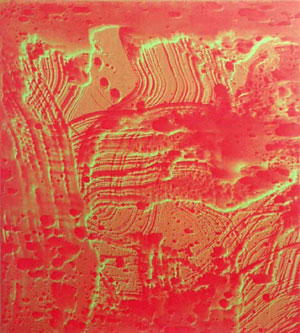|
Take a photograph of a jungle, looking like a moonscape, but then green. Subtract everything that, say, The National Geographic would put in the image. Then, take out all elements that represent anything. Eliminate all colors that deviate from the predominant green. Then – why not, since we are engaged in elimination – take out photography itself. What remains is what exceeds narrative as it has been dominated by realism, the one-to-one relationship between eye or camera and object where the viewer believes that this relationship is referential.
What exceeds is all those things and what “ruins legibility” so radically is what you get when you look at Martijn Schuppers’ painting #0109, for example. His paintings are as riveting as they are because they are based on subtraction. Like all his works, this image looks like a photograph. Abstract like Christiane Richter’s or James Welling’s photographs, yet infused with the phantom of figuration we know from Andres Serrano’s Red River (1989) or Herwig Kempinger’s Ohne Title (1990). These abstract works use photography to undermine the sculptural qualities of the painted surface in abstract art, and use abstraction to undermine the referential dogma of photography(1). They do both things that at ones, while also harboring the trace of what they dismiss so that the images display their differences against the light of memory.
Schuppers does something similar. There is no narrative of events to carry you on its wings into fantasyland. There is no object in whose representation you can believe. Except that there is not even a photograph. Instead, there is painting. A richly painted surface, made so rich by means of subtraction. This strategy effectively revitalizes painting on its own terms, interactively engaged with painting’s history and future. It sounds simple, but its effectivity depends on an extremely complex process that is best explained trough an example that is, at first sight at least, at the opposite end of imaging’s possibilities from Schuppers’ work: figurative photography. But if photography is Schuppers’ work’s “other”, like all forms of otherness the relationship is paradoxical but tight. As will become clear, both figuration and photography haunt these paintings. The jungle, the moon, unknown regions of perception loom large.
(1) For a good survey of the history of abstraction in photography, see Faber (1991)

|
 |

#0109 (2001)
100 x 90 cm. Acrlylic, alkyd and oil on polyester
Private collection Den Haag
|
